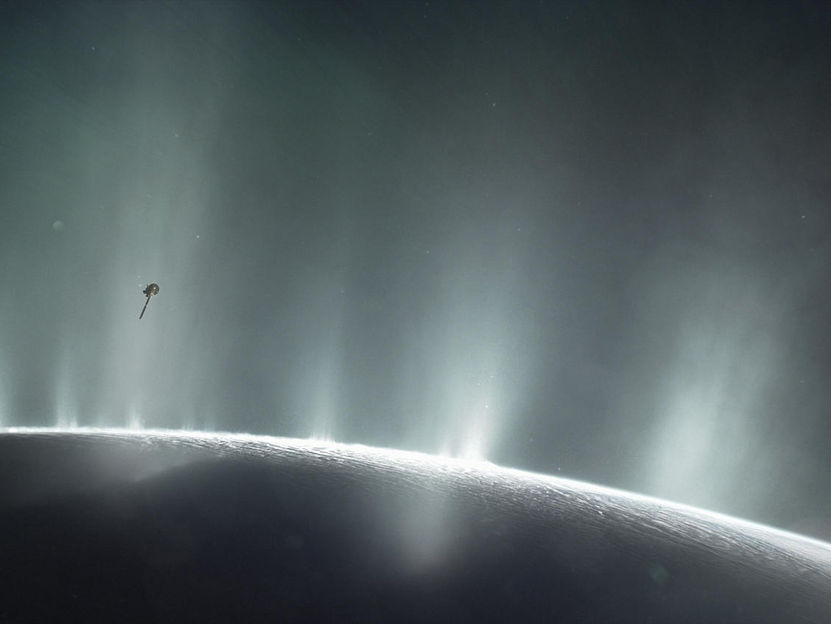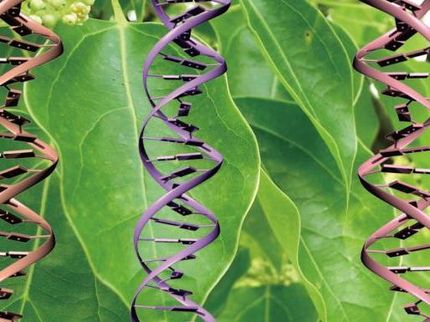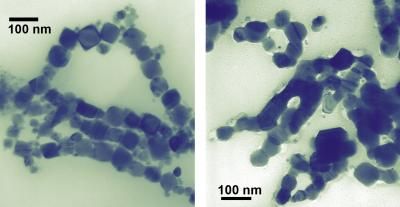New findings could pave the way to detecting the building blocks of life in our solar system
Detecting biomolecules on ocean moons
It would be technically possible for future space missions to detect DNA, lipids, and other bacterial components on ocean moons in our solar system – provided that these building blocks of life do exist beyond Earth. This is the conclusion that has now been reached by an international team of scientists, led by the Planetary Sciences and Remote Sensing research group at Freie Universität Berlin. The experimental study was funded by the European Research Council as part of the Consolidator Grant “Habitat-OASIS” and published in the peer-reviewed scientific journal Astrobiology.

The Cassini spacecraft analyzes ice grains encountered during a flyby of Enceladus.
NASA/JPL-Caltech
Saturn’s moon Enceladus is well-known for the cryovolcanic plumes it emits into space. These plumes are largely comprised of ice grains that come from an ocean of water located deep below the moon’s frozen surface. Similar processes presumably also occur on Jupiter’s moon Europa. Space probes can then analyze these ice grains using impact ionization mass spectrometers, providing insights into the composition of the subsurface ocean water. In novel laboratory experiments, scientists at Freie Universität Berlin successfully simulated the appearance of building blocks of bacteria in ice grain mass spectra for the first time. “In our experiments we demonstrate that future spacecraft would have the technology to be able to detect DNA, lipids, and even metabolic intermediates of these bacteria, provided that such molecules are present in the sampled ice grains,” explains Dr. Fabian Klenner, one of the lead authors of the study. “This would be possible even if the biomolecules were present in only a few ice grains at very low concentrations.”
The scientists analyzed two different types of bacteria as part of their study and found that some of the biomolecules under investigation were clearly distinct, leaving different biological “fingerprints” in the mass spectra depending on the type of bacteria. “This not only means that we can identify bacterial components on extraterrestrial ocean worlds, it also means we can distinguish different types of bacteria from each other,” emphasizes Dr. Klenner.
With NASA’s Europa Clipper mission scheduled to launch to Jupiter’s moon Europa in October 2024, the results of this study couldn’t have come at a better time. After all, the spacecraft will carry an impact ionization mass spectrometer on its mission, with the Planetary Sciences and Remote Sensing group at Freie Universität Berlin playing a significant role in planning and later analyzing the data produced by this equipment. Now that it has been confirmed that the technology is capable of detecting the building blocks of life, the results of the mission have the potential to be very interesting indeed.
The international study was conducted in collaboration with scientists from the University of Zurich, The Open University in Milton Keynes, NASA’s Jet Propulsion Laboratory in California, and Leipzig University.
Original publication
Dannenmann M, Klenner F, Bönigk J, Pavlista M, Napoleoni M, Hillier J, Khawaja N, Olsson-Francis K, Cable ML, Malaska MJ, Abel B, Postberg F (2023) Toward Detecting Biosignatures of DNA, Lipids, and Metabolic Intermediates from Bacteria in Ice Grains Emitted by Enceladus and Europa. Astrobiology 23(1):online ahead of print
Other news from the department science
Most read news
More news from our other portals
See the theme worlds for related content
Topic World Mass Spectrometry
Mass spectrometry enables us to detect and identify molecules and reveal their structure. Whether in chemistry, biochemistry or forensics - mass spectrometry opens up unexpected insights into the composition of our world. Immerse yourself in the fascinating world of mass spectrometry!

Topic World Mass Spectrometry
Mass spectrometry enables us to detect and identify molecules and reveal their structure. Whether in chemistry, biochemistry or forensics - mass spectrometry opens up unexpected insights into the composition of our world. Immerse yourself in the fascinating world of mass spectrometry!
























































